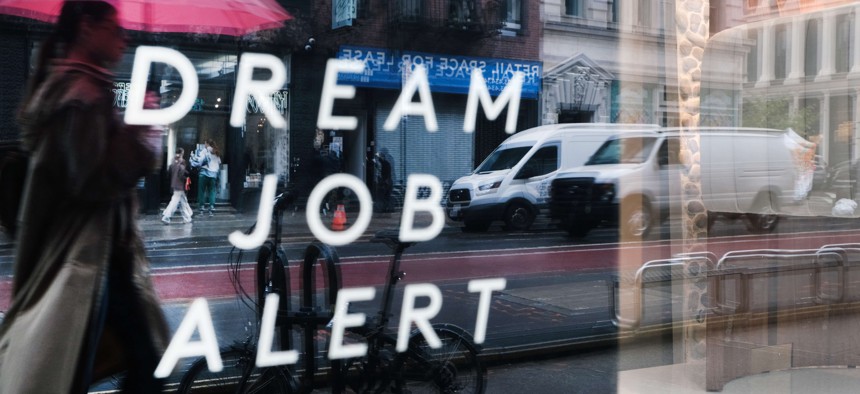The States That Saw Unemployment Rise or Fall in July

A 'help wanted' sign is displayed in a Manhattan store on May 06, 2022 in New York City. Spencer Platt/Getty Images
Fourteen states saw significant drops in unemployment, according to new federal data, as the Biden administration touted a record-high number of states with jobless rates at or below 3%.
Fourteen states and the District of Columbia saw notable unemployment declines in July compared to June, with New Mexico seeing the biggest dip, according to federal statistics released Friday.
President Biden seized on the unemployment figures, saying that 22 states, a record high number, have unemployment rates at or below 3%. "This is the latest sign that my Administration’s economic plan is working," Biden added in a statement.
The Bureau of Labor Statistics data show that only three states saw unemployment rise in July, although each of these states had jobless rates that were still below the national rate. Indiana's rate increased by 0.2 percentage points to 2.6% and Montana's and Nebraska's by 0.1 percentage points, to 2.7% and 2% respectively.
The national unemployment rate in July was 3.5% and unemployment was down in all 50 states compared to a year ago.
Despite the positive jobless numbers, many Americans have been downbeat about the economy this summer amid high inflation and elevated prices for necessities like rent and gasoline.
In New Mexico the unemployment rate fell to 4.5% in July from 4.9% in June. (For other states with significant unemployment changes from June to July, see the chart below.)

The BLS figures also show which states had unemployment rates in July that were significantly different than the national rate. (See chart below.) On the high end, this includes New Mexico, as well as Washington, D.C. with a rate of 5.2% and Alaska, 4.5%.
States with the lowest rates included Minnesota, 1.8% and Nebraska, New Hampshire and Utah, all with 2% unemployment rates.

Mixed Jobs Market
The U.S. labor market is showing some mixed signals. For instance, many sectors are still grappling with labor shortages and recruiting challenges that emerged during the pandemic. But some companies, particularly in the tech and real estate industries, have been slowing hiring or cutting jobs.
The consultancy PwC surveyed 722 U.S. executives during early August and found that 63% are changing processes to address labor shortages and that 38% see talent acquisition as a serious risk. Seventy percent of respondents said they were expanding permanent remote work options for some employees and 64% increasing pay.
Yet, at the same time, the poll results show that half of the executives' firms had plans to reduce employee head counts and 52% were instituting hiring freezes. Others are taking steps like lowering or dropping signing bonuses (46%) or rescinding offers (44%).
"This comes as no surprise," the report says of companies dialing back payrolls and hiring efforts. "After a frenzy of hiring and a tight labor market over the past few years, executives see the distinction between having people and having people with the right skills."
The U.S. Chamber of Commerce noted last month that some of the industries with the greatest numbers of job openings included transportation, health care, social assistance and lodging and restaurants. The Chamber also said that durable goods manufacturers, wholesale and retail trade and education and health care had more job openings than unemployed workers with experience in those fields.
"Even if every unemployed person with experience in the durable goods manufacturing industry were employed, the industry would only fill 65% of the vacant jobs," the group said.
Bill Lucia is executive editor of Route Fifty.
NEXT STORY: Dozens of State and Local Officials Press Biden to Increase Refugee Resettlement in US






